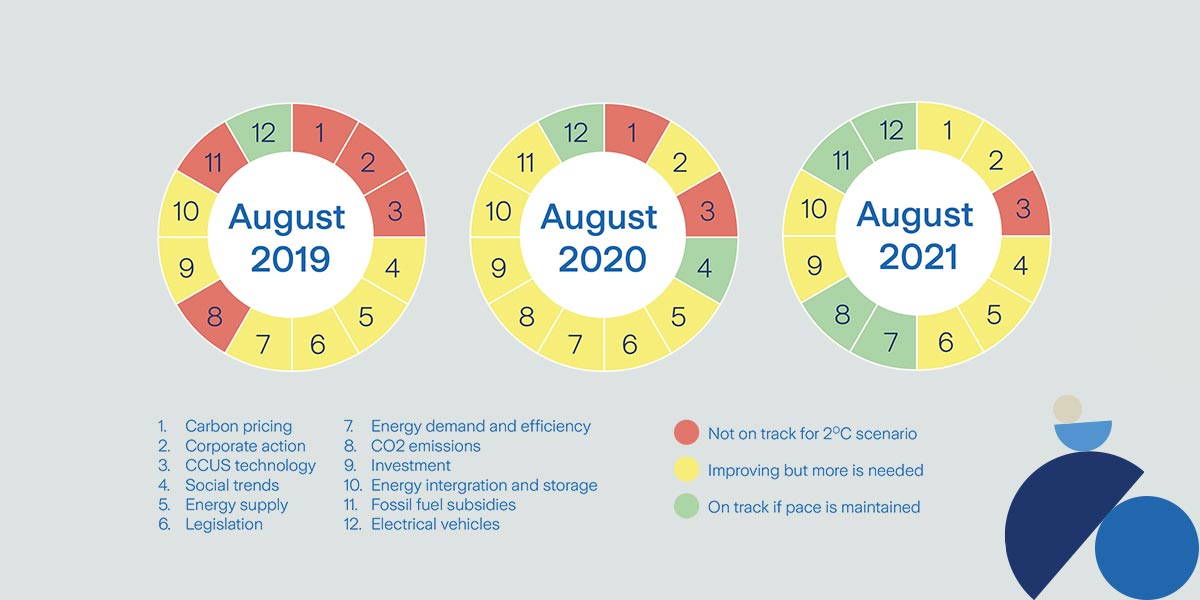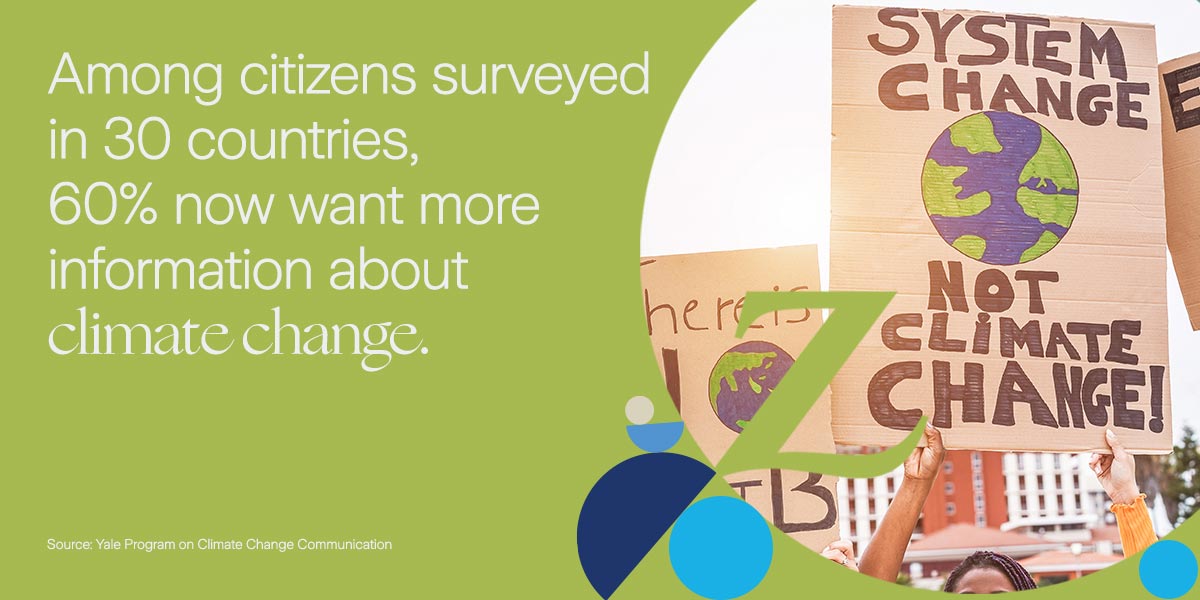5 reasons to be optimistic in the fight against climate change
Climate resilienceArticleOctober 12, 20218 min read
Tackling climate change is arguably humanity’s biggest ever challenge. Can we save our planet? Here are five key signs of recent progress.
It is perhaps unsurprising that you rarely see the words ‘climate change’ and ‘optimism’ in the same headline.
The world’s forests, oceans and polar ice caps remain in peril, extreme weather events are growing fiercer and more frequent, and we are not on track to achieving the key ambition of the 2015 Paris Agreement: to limit global warming to significantly less than 2°C, and ideally 1.5°C, by the end of the century. Combating climate change is a monumental undertaking that will require a complete reshaping of the global economy, energy, transport, and agricultural systems.
Thankfully, among this dizzying array of challenges, it’s also possible to see some green shoots of progress. And in order to provide a clear, data-led picture of the latest positive and negative trends, Zurich Insurance Group (Zurich) has created an annual Climate Change Scorecard. Since 2017, it has measured 12 climate change-related metrics, as Charlotta Groth, Global Macroeconomist at Zurich, explains:
“Our Scorecard uses published data across three climate change-related areas where we need to see critical progress. The first area is policy, particularly around carbon pricing and regulation, but also things such as subsidies to the fossil fuels sector. The second area is technologies that will enable us to tackle the challenge of climate change. And the third is social trends, including green investment, business practices, and how environmental issues are reported and understood around the world.”
The first piece of cheering news is that the 2021 Climate Change Scorecard is a little greener compared to previous years. However, this was largely due to the COVID-19 pandemic, as a slump in economic activity caused a corresponding drop in the demand for energy and CO2 emissions. But there is more to feel upbeat about. Focusing on some of the positive news highlighted in Zurich’s Climate Change scorecard, here are five reasons to be at least cautiously optimistic, while recognizing the urgent need for far-reaching change:

1. A growing awareness of the climate crisis – despite COVID-19
There was an understandable fear among environmental groups that the pandemic and subsequent economic fallout would push climate change concerns to the margins of the public and political agenda. Thankfully, says Charlotta Groth, this did not happen: “One encouraging sign for me is that awareness about climate change has survived the COVID crisis. We all remember that last year the world was experiencing some very urgent and difficult times. Despite this, climate awareness survived. Looking forward, businesses now need to start seeing net-zero as an opportunity rather than just a risk.”
The data bears this out, with one study by the Yale Program finding that among citizens surveyed in 30 countries and territories around the world, 60 percent now want more information about climate change. There were also significant majorities in most countries surveyed saying that they are aware that climate change is happening, are actively worried about it, support the Paris Agreement, and think that climate change should be a priority for their respective national governments. One note of caution to sound is that awareness of important issues does not automatically translate into political or indeed individual action. But it is a good place to start.
2. The rise of renewable energy
The statistics on renewable energy sources are also encouraging. According to the International Energy Agency (IEA), electricity generation from renewables increased by almost 7 percent in 2020 and is predicted to rise by more than 8 percent in 2021. This is the fastest year-on-year growth since the 1970s and will mean that renewables will generate almost a third (30 percent) of the world’s energy this year. And when they are combined with nuclear power, low-carbon power sources are predicted to surpass the world’s coal plants for the first time.
However, once again, there are caveats. As John Scott, Head of Sustainability Risk at Zurich, points out, the growth of renewables must go hand in hand with the implementation of new technologies and infrastructure. “All sorts of fundamental technologies need to be in place to manage the intermittency of energy supply from renewables,” says Scott. “These include smart power grids to manage both supply and demand, and grid-scale energy storage.”

And although the line on the renewable energy graph is heading in the right direction, the pace of change must accelerate. In fact, to achieve net-zero emissions by 2050, annual global investment in clean energy must more than triple by 2030 to USD 4 trillion. While renewable sources must account for 90 percent of global electricity generation by 2050, up from 29 percent last year.
3. Electric vehicles take to the road
To help the world achieve net-zero by 2050, the IEA predicts that electric vehicles must contribute 60 percent of total passenger car sales by 2030 and become the global norm for nearly all passenger vehicles 20 years later. This represents a huge transformation, but there is encouraging evidence of a market shift. In 2020, sales of electric cars increased by 41 percent to 3 million vehicles – a significant upswing, contributing to the 10 million electric vehicles now driving on the world’s roads. Although this only represents 1 percent of the global car stock, so there is a long way to go.
Alongside electric vehicles, other green transport solutions in development include vehicles powered by zero-carbon hydrogen fuel cells, which could be of particular benefit in long-distance commercial transportation by replacing diesel. Transport is a clearly a key sector in the fight against climate change and one that is benefitting from a convergence of new technology with rising consumer demand.
4. Counting the costs of carbon
One of the key economic strategies to combat global warming is the introduction of carbon pricing, which involves applying a tariff or levy, or some other mechanism such as a shift in subsidies that recognizes the economic value of carbon. This creates a financial incentive for companies and households to reduce emissions, while simultaneously encouraging investment in green technologies, including those designed to remove carbon from the atmosphere.
The ultimate aim – to create a globally recognized price for carbon – is politically difficult to achieve, at least for now. But the expansion of voluntary carbon markets and the development of “carbon single markets” that span several jurisdictions show how a collaborative global strategy on carbon pricing can be achieved.
As Charlotta Groth says: “I think the real challenge going forward is: how do we decouple economic activity from carbon emissions? It’s about greening the global economy and considering how we are going to finance that transition. What has been done in this area over the past few years is very impressive, but it has to be scaled up massively and that requires huge inflows of finance.” As Groth says, progress is being made: according to the World Bank, 64 carbon pricing instruments are now in operation globally, covering USD 53 billion in revenue, a 17 percent rise from 2020, although the coverage of overall emissions is still very low.
5. Governments commit to a greener world
2021 has seen several encouraging political developments in the fight against climate change. These include the U.S. rejoining the Paris Agreement and aiming to reduce CO2 emissions by between 50 and 52 percent by 2030 compared to 2005 levels, the EU’s ambition to cut CO2 emissions by at least 55 percent by 2030 compared to 1990 levels, and China’s intention to peak its CO2 emissions by 2030 before then achieving carbon neutrality by 2060. The accelerated timetable of these commitments is significant as these newly announced targets must be met within a decade – requiring tangible action in the here and now.
“What we saw in 2021 was a number of accelerated 2030 targets by major regions and economies, which will require reducing carbon emissions by around 40 percent in 2030 compared to 2019 levels,” says Charlotta Groth. “So, I suspect that in a year or two we will know if those new targets were empty promises or dreams – or whether they were for real.”
These examples of progress demonstrate that committed action across a range of key areas is already making a positive difference in the fight against climate change. It also highlights how a depressing truth at the heart of the climate crisis – that global warming is a human-made problem – can be turned on its head to become an environmental rallying cry. If humans are the primary cause of global warming, that means we can also be the architects of its undoing.







